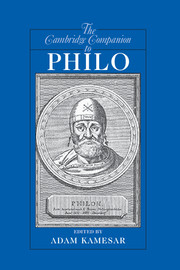7 - Philo and the New Testament
from Part 3 - Philo’s Influence and Significance
Published online by Cambridge University Press: 28 November 2009
Summary
To get a sense of the diffusion of Philo's ideas between his own time and the emergence of a literary corpus Philoneum, we must rely on Christian sources. In the first two centuries CE, these are the only sources that tell us anything about the possible influence of his teachings on the Greek world. The innumerable Greek-speaking synagogues of the Roman Empire, and especially those in the big cities, will have served as relay stations. They must have been places of learning in one way or another, and they did serve as the setting of one of Judaism's most important innovations, public sermons on Holy Scripture. If we assume that more than one teacher like Philo was active in the urban synagogues of antiquity, the diffusion of Philonic language and ideas can be explained by an appeal to oral forms of transmission. All clues to Philo's earliest influence on the Greek-speaking world are hidden in the literary corpus of what was to be called the New Testament. To state this is not a 'canonical' approach. For the present chapter, Christian writings contemporaneous with the New Testament, such as the Epistles of Ignatius of Antioch and the Shepherd of Hermas, are of little interest, because they are devoid of philosophy. And, as regards the documents of early Gnosticism cited by Irenaeus and Hippolytus or contained in the Nag Hammadi library, they have relevance for the question just raised but are chronologically later. The writings of the New Testament that reveal the clearest evidence of at least indirect Philonic influence are the Epistle to the Hebrews and the Gospel of John. It is possible to explain this influence by reference to known historical circumstances.
- Type
- Chapter
- Information
- The Cambridge Companion to Philo , pp. 175 - 209Publisher: Cambridge University PressPrint publication year: 2009
- 2
- Cited by

